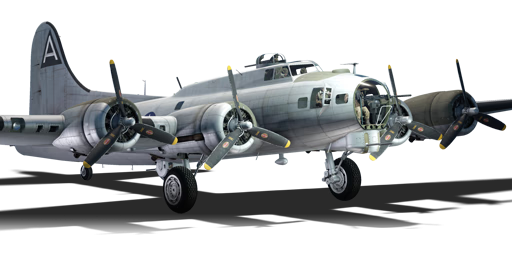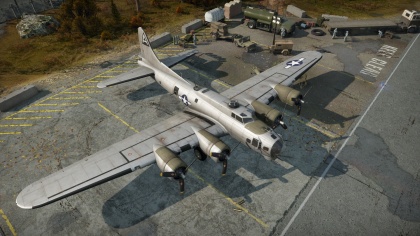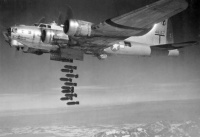B-17G-60-VE
Contents
| This page is about the American bomber B-17G-60-VE. For other uses, see B-17 (Family). |
Description
The B-17G-60-VE Flying Fortress is a rank IV American bomber
with a battle rating of 5.0 (AB), 5.3 (RB), and 6.3 (SB). It has been in the game since the start of the Open Beta Test prior to Update 1.27.
The B-17G Flying Fortress, as the name suggests, is intended to be used as a high-altitude level bomber, designed to target enemy airfields and military bases. Despite its large bomb-load, it is not recommended to target moving ground targets such as tank formations. This due to the inaccuracy of bombs being released at high altitude. When using the B-17G, it is always best to group up with others in a wedge-like formation for optimal defence. The higher you climb the harder of a target you will become. A few fighter escorts, such as a squadron of P-51 Mustangs would ensure the survival of friendly bombers. Survival is the utmost importance to be remembered when using this plane. While you may miss one target, you can always make another pass once you reload and repair.
General info
Flight performance
Describe how the aircraft behaves in the air. Speed, manoeuvrability, acceleration and allowable loads - these are the most important characteristics of the vehicle.
| Characteristics | Max Speed (km/h at 7,680 m) |
Max altitude (metres) |
Turn time (seconds) |
Rate of climb (metres/second) |
Take-off run (metres) | |||
|---|---|---|---|---|---|---|---|---|
| AB | RB | AB | RB | AB | RB | |||
| Stock | 492 | 476 | 11156 | 37.2 | 38.2 | 2.2 | 2.2 | 600 |
| Upgraded | ___ | 507 | __._ | 36 | __._ | 3.3 | ||
Details
| Features | ||||
|---|---|---|---|---|
| Combat flaps | Take-off flaps | Landing flaps | Air brakes | Arrestor gear |
| ✓ | ✓ | ✓ | X | X |
| Limits | ||||||
|---|---|---|---|---|---|---|
| Wings (km/h) | Gear (km/h) | Flaps (km/h) | Max Static G | |||
| Combat | Take-off | Landing | + | - | ||
| 0 | 290 | 400 | 400 | 249 | ~2 | ~1 |
| Optimal velocities (km/h) | |||
|---|---|---|---|
| Ailerons | Rudder | Elevators | Radiator |
| < 360 | < 300 | < 323 | > 310 |
| Compressor (RB/SB) | ||
|---|---|---|
| Setting 1 | ||
| Optimal altitude | 100% Engine power | WEP Engine power |
| 6,180 m | 4,000 hp | 4708 hp |
Survivability and armour
- 6.35 mm Steel - Lower nose armour plate
- 6.35 mm Steel - Back of pilot and co-pilot's seats
- 6.35 mm Steel - Dorsal turret gunner protective plate
- 6.35 mm Steel - Radio operator protective plate
- 6.35 mm Steel - Beam gunner protective armour x 2
- 6.35 mm Steel - Tail gunner protective plate
- 38 mm Bulletproof glass - Ball turret
- 38 mm Bulletproof glass - Tail gunner rear window
Armaments
Suspended armament
The B-17G-60-VE can be outfitted with the following ordnance:
- 8 x 500 lb AN-M64A1 bombs (4,000 lb total)
- 12 x 500 lb AN-M64A1 bombs (6,000 lb total)
- 6 x 1,000 lb AN-M65A1 bombs (6,000 lb total)
- 2 x 2,000 lb AN-M66A2 bombs (4,000 lb total)
- 8 x 1,000 lb AN-M65A1 bombs (8,000 lb total)
- 4 x 2,000 lb AN-M66A2 bombs (8,000 lb total)
Defensive armament
The B-17G-60-VE is defended by:
- 2 x 12.7 mm M2 Browning machine guns, chin turret (400 rpg = 800 total)
- 1 x 12.7 mm M2 Browning machine gun, 2 x cheek turrets (300 rpg)
- 2 x 12.7 mm M2 Browning machine guns, front dorsal turret (500 rpg = 1,000 total)
- 1 x 12.7 mm M2 Browning machine gun, rear dorsal turret (500 rpg)
- 2 x 12.7 mm M2 Browning machine guns, ventral turret (500 rpg = 1,000 total)
- 1 x 12.7 mm M2 Browning machine gun, 2 x beam turrets (600 rpg)
- 2 x 12.7 mm M2 Browning machine guns, tail turret (575 rpg = 1,150 total)
Usage in battles
When facing fighters and interceptors in Realistic Battles, it is best to use Omni-purpose or Armour-piercing/Ground Target ammunition belts for the 12.7 mm M2 Browning machine guns. These ammunition belts are effective at tearing through the engine block and hopefully resulting in an internal engine fire. You may be also able to score a pilot kill on your opponent.
Specific enemies worth noting
B-17s are notoriously hard to kill when compared to similar Soviet and German bombers. However, with the B-17 the best defence is to evade your opponent altogether. Your worst enemies will be almost all fighters due to the high BR (FW-190 D, Ta-152, BF-109 G-10/K-4, F8F-1B, Tempest, etc.). Most fighters will have 2-4 cannons which can still make short work of the B-17.
NOTE: The weakest area of approach with the B-17G is the front. Only 1-2 MGs can be focused directly forward if a fighter head-ons you. The crew is also focused at the nose. If there is a fighter at your level, try to turn and expose the tail "barb". Diving may work as well. However, diving can put you into more danger as more fighters may swarm you.
Counter-tactics
When climbing to fight the B-17, you will most likely have a lower energy level depending on the plane you use. The F8F-1B, for example, has extremely good acceleration with WEP and can climb ridiculously quickly as well. If in a plane such as an F8F-1B, attempt to head on the B-17 as this is the weakest point. If the B-17 turns away, climb and chase the Flying Fortress at a higher altitude and then dive on it from an angle. Always avoid tailing a B-17, regardless of model. This just warrants a knocked-out pilot or fire.
Manual Engine Control
| MEC elements | ||||||
|---|---|---|---|---|---|---|
| Mixer | Pitch | Radiator | Supercharger | Turbocharger | ||
| Oil | Water | Type | ||||
| Controllable | Controllable Auto control available |
Not controllable Not auto controlled |
Controllable Auto control available |
Combined | Controllable 1 gear |
Auto controlled |
Modules
| Tier | Flight performance | Survivability | Weaponry | ||
|---|---|---|---|---|---|
| I | Fuselage repair | Radiator | Protective vest | Turret 12 mm | LBC-17 |
| II | Compressor | Airframe | SBC-17 | ||
| III | Wings repair | Engine | New 12 mm MGs (turret) | MBC-17 | |
| IV | Engine injection | Cover | M10 bomb rack | ||
This slow and lumbering heavy bomber relies entirely on its turrets for defence. Without it, the plane is target practice. Thus "Protective vests" should be the first unlock. Further survivability upgrades will make the fight easier, but do not think it will successfully face-off against enemy fighters. So upgrading the bomb payloads should be second priority. Performance modules can be considered the least necessary.
Pros and cons
Pros:
- Large bomb payload
- Powerful air defence capabilities
- Multiple engines
- Overall heavily armoured
Cons:
- Big target
- Fairly slow
- Nose is extremely vulnerable for the pilot and crew
- Vulnerable to German "Minengeschoße" and >20 mm gunfire
- Engine fires are common
- Wings are big and thus commonly torn off by gunfire
- Aggressive turns may snap wings
- All fuel tanks are located in the wings and are prone to catching fire and damaging/destroying wings
- Can encounter early jets
History
Due to direct experience from U.S. bomber crews in 1943, the B-17F revealed inadequate protection from head-on attacks by enemy fighters. To remedy this problem, a remote-controlled chin turret armed with two 12.7 mm M2 Browning machine guns was introduced on the final production block of Douglas-built B-17Fs, the B-17F-75-DL. This turret became standard on the B-17G, and proved to be more practical than manually operated guns initially fitted to the nose. The B-17G began delivery in September of 1943 and included various upgrades throughout its production. A total of 8,680 aircraft were built from three manufacturers until April of 1945. The B-17G could be considered the cornerstone of U.S. bombing efforts in the European theatre between 1944 and 1945.
In-game description
The Boeing B-17G Flying Fortress was the first American all-metal heavy bomber. The plane was designed in 1934 in response to a design competition for a coastal anti-ship bomber. A year later the Boeing-299 prototype was built, equipped with four 750-HP Pratt & Whitney engines. It was first flown on June 28 of that year. Subsequent variants used the 1,200 HP Wright Cyclone engines. Boeing factories began mass producing B-17 Flying Fortresses for the US Army Air Corps exactly 12 months later. Throughout the production run, Boeing produced 6,981 B-17s of various variants and an additional 5,745 were built by Lockheed and Douglas giving a total of 12,726 aircraft.
The B-17 quickly became legendary due to its ability to withstand battle damage and to bring hole-ridden aircraft home safely. Nine, and later twelve, Browning .50-cal machine guns offered formidable defensive fire coverage. Nevertheless, the aircraft was not without its faults. For example, the tendency to catch fire was never overcome. Another weakness was the lack of protection against head-on attacks; out of 27 pieces of armor, none protected the crew from the front. Firing a cannon or even a machine gun at the cockpit would find the crew completely unprotected. Another famous part of the B-17 was its highly advanced Norden bombsight, which allowed for effective bomb aiming even at high altitudes.
Media
Excellent additions to the article would be video guides, screenshots from the game, and photos.
See also
Links to the articles on the War Thunder Wiki that you think will be useful for the reader, for example:
- reference to the series of the aircraft;
- links to approximate analogues of other nations and research trees.
External links
Paste links to sources and external resources, such as:
- topic on the official game forum;
- encyclopedia page on the aircraft;
- other literature.
| Boeing Aircraft | |
|---|---|
| Aircraft | |
| Fighters | P-26A-33 · P-26A-34 M2 · P-26B-35 |
| Bombers | B-17E · B-17E/L · B-17G-60-VE |
| B-29A-BN | |
| Export | P-26A-34 · B-17G |
| Captured | ▅B-17E |
| Helicopters | |
| Attack | AH-64A · AH-64D |
| Export / Licensed | AH-64A (GR) · ▃AH-64A Peten · AH-64A Peten · ▅AH-64DJP · ▄AH Mk.1 · AHS |
| See Also | Tupolev Design Bureau · Westland Helicopters · Fuji Heavy Industries |
| For Boeing-built ships, see Boeing Marine Branch | |
| USA bombers | |
|---|---|
| Dive | SB2U-2 · SB2U-3 · SBD-3 · SB2C-1C · SB2C-4 |
| Torpedo | TBD-1 · PBY-5 Catalina · PBY-5A Catalina · TBF-1C · BTD-1 |
| Medium | B-10B · B-18A · B-34 · PV-2D · B-25J-1 · B-25J-20 · A-26C-45 · A-26C-45DT · B-26B |
| Heavy | B-17E · B-17E/L · B-17G-60-VE · PB4Y-2 · B-24D-25-CO · B-29A-BN |
| Hydroplanes | OS2U-1 · OS2U-3 · PBM-1 "Mariner" · PBM-3 "Mariner" |






